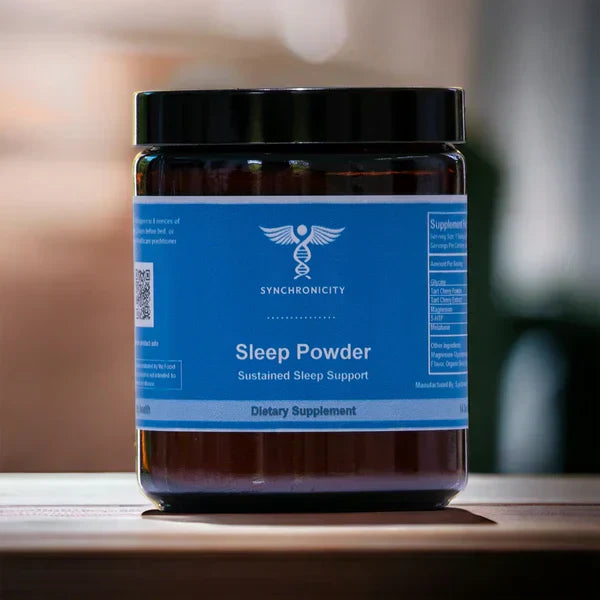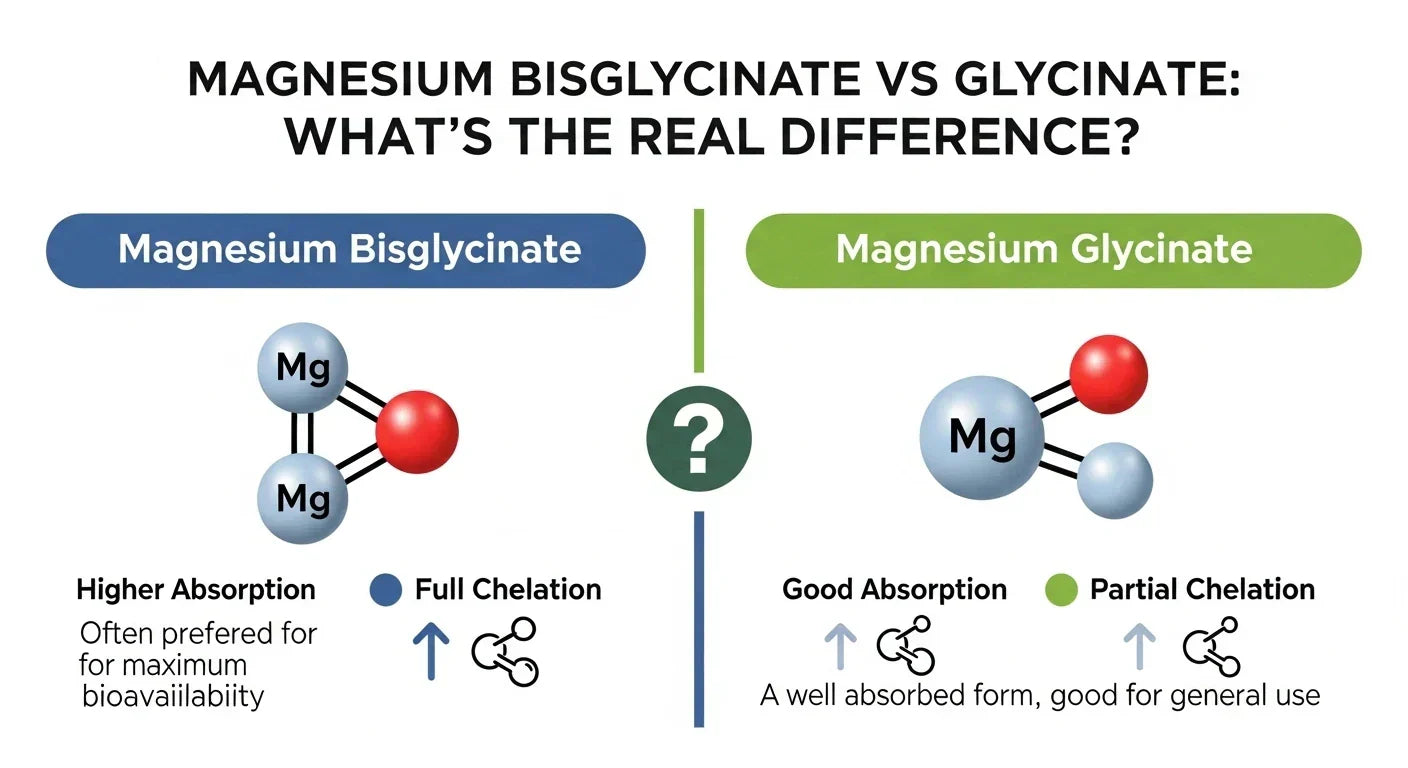More and more people are turning to magnesium malate for a natural boost in energy, sleep, and recovery. By combining magnesium, a mineral involved in over 300 bodily processes with malic acid, a natural compound found in fruit, magnesium malate offers support for cellular energy production, muscle relaxation, and mental clarity.
Whether you're managing stress, fatigue, or poor sleep, this guide breaks down everything you need to know about its benefits, dosage, and how it fits into your wellness routine.
What Is Magnesium Malate?
It is a well absorbed form of magnesium combined with malic acid, a compound that plays a critical role in energy production. This supplement is increasingly used to support people with low energy, muscle tension, brain fog, and poor sleep. In this blog, we’ll break down what magnesium malate is, how it’s made, and why it’s different from other magnesium supplements.
What Is Magnesium Malate Made Of?
It is a compound formed by binding elemental magnesium with malic acid, a naturally occurring substance found in fruits like apples. This chelated form of magnesium allows for better absorption in the body, making it a preferred choice for those seeking both physical energy and cognitive clarity.
How It Supports Cellular Energy and Recovery
Malic acid plays a critical role in the Krebs cycle, the process your body uses to produce cellular energy (ATP). When paired with magnesium—a mineral essential for over 300 biochemical reactions—the result is a supplement that not only replenishes magnesium levels but also enhances energy metabolism and recovery.
Why It’s Different From Other Forms
Unlike magnesium oxide or citrate, this form boasts high bioavailability and gentler gastrointestinal tolerance. While magnesium taurate is more targeted toward heart and mood support, malate excels in promoting cellular energy making it a smart choice for those dealing with fatigue, muscle soreness, or low stamina.
Key Benefits of It
This offers a unique combination of cellular energy support, muscle recovery, and neurological balance. In this section, we’ll explore its most important benefits—backed by science and user experience.
Energy Production & Chronic Fatigue Relief
One of the main reasons people choose this supplement is its effect on energy production. Malic acid supports mitochondrial function, helping the body generate more ATP. As a result, it’s particularly helpful for those dealing with chronic fatigue syndrome or persistently low energy levels.
Muscle Support and Post-Workout Recovery
Magnesium plays a key role in helping muscles relax after contraction. When paired with malic acid, this form supports faster recovery and helps minimize cramping or soreness after physical activity.
Cognitive Clarity, Brain Fog Reduction, and ADHD Support
Emerging evidence suggests this compound may enhance mental clarity and reduce brain fog, particularly in individuals experiencing chronic stress or managing ADHD. The presence of malic acid, known for boosting cellular energy, also contributes to improved cognitive stamina.
Potential Role in Nerve Pain and Fibromyalgia
Some research and user reports associate this supplement with reduced fibromyalgia symptoms and nerve-related discomfort. Its ability to soothe overactive nerve pathways and aid muscle performance may explain these effects.
How It Works in the Body
Role of Malic Acid in Mitochondrial Function
Malic acid is a central player in the Krebs cycle, helping convert food into usable energy. When delivered in combination with magnesium, it boosts mitochondrial efficiency and reduces feelings of sluggishness.
Bioavailability and Absorption: Is It Water Soluble?
It is water soluble and known for its high bioavailability. This means it is readily absorbed through the digestive tract and less likely to cause gastrointestinal issues compared to other forms like magnesium oxide.
Does It Bind to Toxins or Support Detox?
While not a traditional detox supplement, this form may assist the body's natural detoxification by enhancing mitochondrial function and energy availability—both essential for liver health and cellular repair.
Magnesium Malate Dosage and Timing
Recommended Daily Dose for Adults and Children
A standard adult dosage ranges from 200 to 400 mg of elemental magnesium per day, often split into two doses. Children should only take it under professional guidance, especially if being considered for ADHD support.
When to Take It: Morning, Evening, With or Without Food
For energy support, it's best taken in the morning or early afternoon. It can be taken with or without food, though pairing it with meals may improve tolerance.
For energy support, it's ideal to take this supplement in the morning or early afternoon. It can be taken with or without food, though consuming it alongside meals may enhance tolerance.
To support better sleep, some individuals combine it with calming nutrients like GABA, L-theanine, and glycine. These ingredients are included in ourSleep Powder formula, crafted to encourage restful sleep while aiding muscle recovery and nervous system balance.
Dosage Considerations for Fatigue, Nerve Pain, ADHD, and More
Higher doses may be needed for individuals managing chronic fatigue, nerve pain, or cognitive challenges, but should always be supervised by a healthcare provider. Starting low and increasing gradually is generally recommended.
Who Should Take This Supplement
Athletes, Professionals, and Those Under Stress
Those who regularly push their physical or mental limits may benefit from the cellular energy support this supplement offers. It’s commonly used by athletes, high-performing professionals, and individuals coping with stress or burnout.
People with Chronic Fatigue or Magnesium Deficiency
Persistent tiredness despite adequate rest can sometimes signal magnesium depletion. This formula may help restore balance and improve energy metabolism for those struggling with fatigue or deficiency.
Is It Safe for Kids or the Elderly?
Yes under medical guidance. It may be especially helpful for children with attention challenges or seniors experiencing muscle tightness and cognitive changes.
Choosing the Right Supplement
Magnesium Malate vs Magnesium Malate Trihydrate
Magnesium malate trihydrate is a common, stable form used in most supplements. While chemically similar, the "trihydrate" label indicates it contains three water molecules, which doesn't affect efficacy but may influence manufacturing or capsule size.
What to Look for in a High-Quality Supplement
Choose a product that lists the amount of elemental magnesium, is third-party tested, and is free from GMOs, gluten, and artificial additives. Chelated forms like magnesium malate are ideal for absorption.
Why Synchronicity Health Formula Stand Out
Our magnesium malate is clean, bioavailable, and rigorously tested. It is also a key ingredient in ourSleep Powder formula, which combines calming amino acids and bioavailable magnesium to support both mental clarity during the day and deep rest at night.
Side Effects, Safety, and Interactions
It is usually safe, but it's good to know how it might affect you or mix with other medicines.
Is Magnesium Malate Safe?
Yes, it is considered safe for most individuals when taken as directed. It is gentler on the stomach than many other forms.
Common Side Effects and What to Watch For
Some people may experience mild digestive issues like bloating or loose stools at higher doses. Reducing the dose or taking it with food often resolves these issues.
Drug Interactions and Who Should Avoid It
Magnesium may interact with certain medications, including antibiotics and diuretics. Always consult a healthcare provider before starting supplementation, especially if you have kidney disease or are pregnant.
Backed by Science: What the Research Says
Scientists have been studying this form of magnesium to see how it helps the body and brain. Here's what they’ve found so far:
Clinical Studies on Magnesium Malate Benefits
Studies suggest it may reduce symptoms of fibromyalgia, support energy in chronic fatigue syndrome, and aid cognitive function in stressed individuals.
Research on Chronic Fatigue, ADHD, and Fibromyalgia
Magnesium malate is being explored for its impact on neurological health, especially for children with ADHD and adults with chronic fatigue.
Emerging Applications in Cognitive and Metabolic Health
Ongoing research is evaluating its role in metabolic syndrome, detox pathways, and long-term brain health.
Conclusion
Magnesium malate is a helpful supplement for many people. It supports energy, muscle recovery, and clear thinking. Whether you're an athlete, always tired, or feeling stressed, it can make a big difference in how you feel.
To start safely, take a small amount and see how your body reacts. You can increase the dose slowly if needed. Always check with a doctor first if you take other medicines or have health problems.
At Synchronicity Health, we care about your well-being. That’s why we use clean, proven ingredients in all our products. Magnesium malate is part of our Sleep Powder, made to help you relax, sleep better, and wake up feeling refreshed.
Frequently Asked Questions
What Is Magnesium Malate Used to Treat?
It’s often used for fatigue, fibromyalgia, muscle pain, cognitive fog, and magnesium deficiency.
Why Choose Magnesium Malate Over Other Forms?
It offers high absorption, low digestive side effects, and unique support for mitochondrial energy.
Can You Take Too Much Magnesium Malate?
Yes. Excessive intake may cause diarrhea or imbalances. Stick to recommended doses.
How Long Until You Notice the Effects?
Many users report improved energy and clarity within 1–2 weeks. Results vary based on baseline deficiency and overall health.
Does It Help with Brain Fog or Sleep?
Yes, it may reduce brain fog. While not a sleep aid, improved magnesium levels can support overall relaxation and sleep when combined with complementary nutrients like those found in our Sleep Powder supplement.




Leave a comment
All comments are moderated before being published.
This site is protected by hCaptcha and the hCaptcha Privacy Policy and Terms of Service apply.